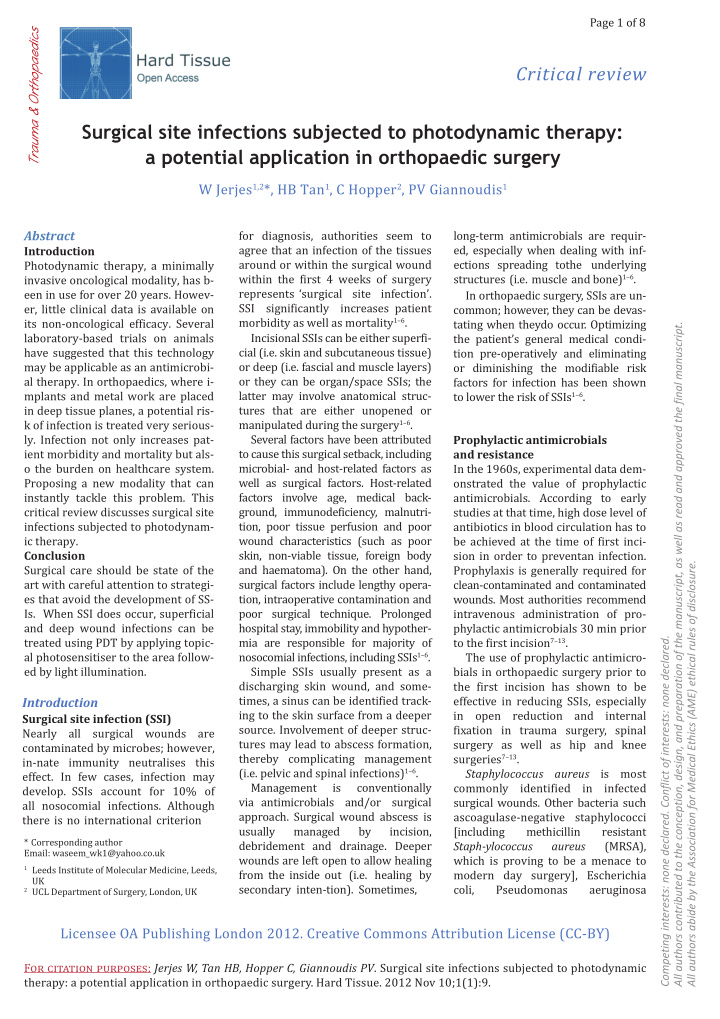



Trauma & Orthopaedics Page 1 of 8 Critical review Surgical site infections subjected to photodynamic therapy: a potential application in orthopaedic surgery W Jerjes 1,2 *, HB Tan 1 , C Hopper 2 , PV Giannoudis 1 Abstract for diagnosis, authorities seem to long-term antimicrobials are requir- agree that an infection of the tissues ed, especially when dealing with inf- Introduction around or within the surgical wound ections spreading to the underlying Photodynamic therapy, a minimally within the first 4 weeks of surgery structures (i.e. muscle and bone) 1–6 . invasive oncological modality, has b- represents ‘surgi cal site infection’. een in use for over 20 years. Howev- In orthopaedic surgery, SSIs are un- SSI significantly increases patient er, little clinical data is available on common; however, they can be devas- morbidity as well as mortality 1–6 . its non-oncological efficacy. Several tating when theydo occur. Optimizing All authors contributed to the conception, design, and preparation of the manuscript, as well as read and approved the final manuscript. laboratory-based trials on animals Incisional SSIs can be either superfi- the patient’s general medical condi- have suggested that this technology cial (i.e. skin and subcutaneous tissue) tion pre-operatively and eliminating may be applicable as an antimicrobi- or deep (i.e. fascial and muscle layers) or diminishing the modifiable risk al therapy. I n orthopaedics, where i- or they can be organ/space SSIs; the factors for infection has been shown mplants and metal work are placed latter may involve anatomical struc- to lower the risk of SSIs 1–6 . in deep tissue planes , a potential ris - tures that are either unopened or k of infection is treated very serious- manipulated during the surgery 1–6 . ly . Infection not only increases pat - Several factors have been attributed Prophylactic antimicrobials ient morbidity and mortality but als - to cause this surgical setback, including and resistance o the burden on healthcare system. microbial- and host-related factors as In the 1960s, experimental data dem- Proposing a new modality that can well as surgical factors. Host-related onstrated the value of prophylactic instantly tackle this problem. This factors involve age, medical back- antimicrobials. According to early critical review discusses surgical site ground, immunodeficiency, malnutri- studies at that time, high dose level of infections subjected to photodynam - tion, poor tissue perfusion and poor antibiotics in blood circulation has to ic therapy. wound characteristics (such as poor be achieved at the time of first inci- Conclusion skin, non-viable tissue, foreign body sion in order to preventan infection. All authors abide by the Association for Medical Ethics (AME) ethical rules of disclosure. Surgical care should be state of the and haematoma). On the other hand, Prophylaxis is generally required for art with careful attention to strategi- surgical factors include lengthy opera- clean-contaminated and contaminated es that avoid the development of SS- tion, intraoperative contamination and wounds. Most authorities recommend Is. When SSI does occur, superficial poor surgical technique. Prolonged intravenous administration of pro- and deep wound infections can be hospital stay, immobility and hypother- phylactic antimicrobials 30 min prior treated using PDT by applying topic- mia are responsible for majority of to the first incision 7–13 . Competing interests: none declared. Conflict of interests: none declared. al photosensitiser to the area follow- nosocomial infections, including SSIs 1–6 . The use of prophylactic antimicro- ed by light illumination. Simple SSIs usually present as a bials in orthopaedic surgery prior to discharging skin wound, and some- the first incision has shown to be Introduction times, a sinus can be identified track- effective in reducing SSIs, especially ing to the skin surface from a deeper in open reduction and internal Surgical site infection (SSI) source. Involvement of deeper struc- fixation in trauma surgery, spinal Nearly all surgical wounds are tures may lead to abscess formation, surgery as well as hip and knee contaminated by microbes; however, thereby complicating management surgeries 7–13 . in- nate immunity neutralises this (i.e. pelvic and spinal infections) 1–6 . Staphylococcus aureus is most effect. In few cases, infection may Management is conventionally commonly identified in infected develop. SSIs account for 10% of via antimicrobials and/or surgical surgical wounds. Other bacteria such all nosocomial infections. Although ap proach. Surgical wound abscess is ascoagulase-negative staphylococci there is no international criterion usu ally managed by incision, [including methicillin resistant * Corresponding author debridement and drainage. Deeper Staph-ylococcus aureus (MRSA), Email: waseem_wk1@yahoo.co.uk wounds are left open to allow healing which is proving to be a menace to 1 Leeds Institute of Molecular Medicine, Leeds, from the inside out (i.e. healing by modern day surgery], Escherichia UK secondary inten-tion). Sometimes, coli, Pseudomonas aeruginosa 2 UCL Department of Surgery, London, UK Licensee OA Publishing London 2012. Creative Commons Attribution License (CC-BY) F�� �������� ��������: Jerjes W, Tan HB, Hopper C, Giannoudis PV . Surgical site infections subjected to photodynamic therapy: a potential application in orthopaedic surgery. Hard Tissue. 2012 Nov 10;1(1):9.
Recommend
More recommend